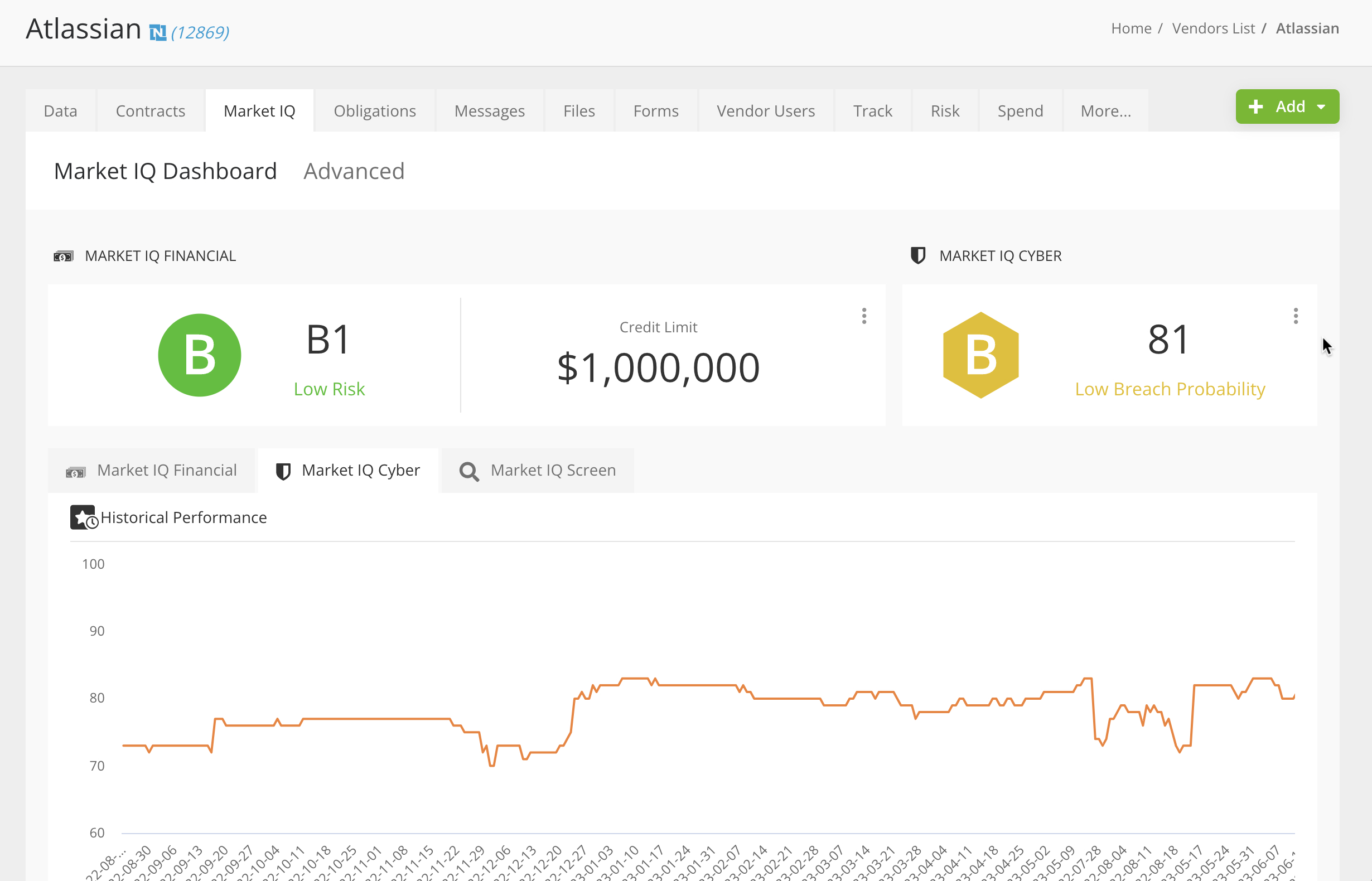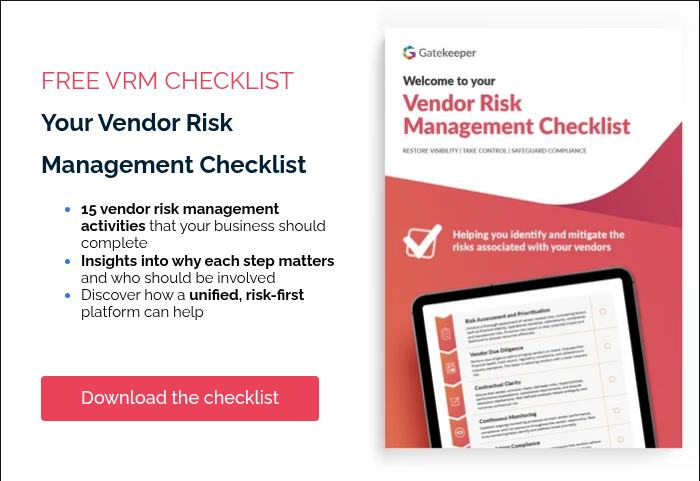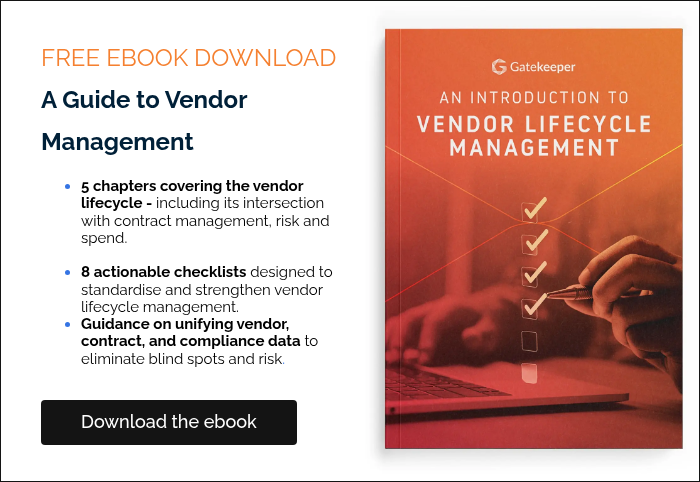How much does your business's success rely on its vendors?
You might naturally think about their performance: did they fulfil their obligations, was everything delivered on time and is the relationship beneficial?
But your vendors’ compliance should be at the top of your mind.
Especially if you’re working in a regulated industry.
If your vendors are non-compliant, your organisation could face severe consequences.
This includes fines that could see your business operations suspended or permanently destroyed.
Vendor compliance is directly linked to your business’s success.
It’s time to make it a priority.
What is vendor compliance?
Vendor compliance is the process of ensuring that vendors adhere to the specific terms, conditions, and standards outlined in their contracts.
This includes meeting quality standards, delivering products or services on time, respect intellectual property rights and adhering to ethical practices.
Vendors also need to comply with industry regulations and legal requirements such as:
- Health Insurance Portability and Accountability Act (HIPAA)
- Food and Drug Administration (FDA) regulations
- General Data Protection Regulation (GDPR)
- California Consumer Privacy Act (CCPA)
- Anti-Money Laundering (AML) regulations
Vendor non-compliance can damage your company's reputation, operations and bottom line. Notable penalties include:
- Banner Health paid $1.25 million for a breach that affected 2.81 million patients due to inadequate risk assessment and security measures
- Morgan Stanley faced a $60 million fine due to ineffectively assessing risks associated with hardware decommissioning and inadequately assessing third-party vendor risks - which led to some machines still containing unencrypted data.
- Dedalus Biologie, a company selling software solutions for medical analysis laboratories, was fined €1.5 million due to their failure to comply with specific Articles of GDPR, which relate to processing the security of processing data.
If your business can’t guarantee vendor compliance, can it guarantee it will survive the consequences?
The Limitations of Traditional Vendor Compliance Management
Procurement professionals without the right technology know the following scenario all too well:
Your desk is cluttered with stacks of vendor contracts, your email inbox is overflowing with back-and-forth communications, and your calendar is packed with face-to-face meetings and physical audits."
The painstaking process of assessing, selecting and adding new vendors to a spreadsheet, manually updating them every time a vendor submits a new report or changes their status is not just time-consuming but fraught with stress and the risk of human error.
Manual vendor compliance management lends itself to:
- Inconsistent Compliance Monitoring: Difficulty in uniformly applying and monitoring compliance standards across all vendors.
- Delayed Identification of Non-Compliance: Slow detection of non-compliance issues due to manual checks, increasing the risk of prolonged non-compliant operations.
- Inadequate Risk Assessment: Challenges in conducting thorough risk assessments for each vendor without automated tools.
- Document Management Issues: Risk of losing or mismanaging critical compliance documents, leading to gaps in compliance records.
- Limited Audit Trails: Difficulty in maintaining comprehensive audit trails for compliance verification and reporting.
- Overlooked Regulatory Updates: Risk of missing critical regulatory updates or changes in compliance standards due to manual tracking methods.
Why Vendor Compliance Needs to be Digitalised
Digitalising and automating vendor compliance processes is becoming increasingly necessary due to the growing complexity of supply chains, the increasing number of regulations, and the need for greater efficiency and accuracy.
According to KPMG, as businesses head into 2024, “Expanded regulatory “perimeters,” innovative technologies, rapidly evolving products and services, growing interconnectedness, and the global political environment are contributing to heightened supervision and examination by all regulators, acting independently and in coordination, at the state, federal, and international levels, significantly enhancing the complexity of regulatory compliance.”
By leveraging technology such as a Vendor and Contract Lifecycle Management (VCLM) platform, that monitors your vendors 24/7/365 and notifies you of risks proactively, you can digitalise and automate your vendor compliance activities.
Your business will be equipped to proactively identify, assess and mitigate risks which was impossible via the traditional method of vendor compliance.
This proactive approach to compliance management is key in an era where reactive strategies are no longer sufficient to protect against fast-evolving changes in regulations and an explosion of data.
Why VCLM is Important for Vendor Compliance
Vendor and Contract Lifecycle Management (VCLM) offers a robust framework for managing vendor relationships and ensuring compliance. It integrates three key elements:
- Vendor Lifecycle Management (VLM)
- Contract Lifecycle Management (CLM)
- Third-Party Risk Management (TPRM)
Crucial functions of VCLM include vendor onboarding and due diligence, prioritising third-party risk management, and automatically monitoring adherence to regulatory compliance standards."
Vendor Lifecycle Management (VLM) is the foundation. It extends beyond contracts to encompass the overall relationship with vendors. VLM involves the selection, onboarding, performance monitoring, and offboarding of vendors.
It ensures that vendors not only comply with contract terms but also align with organisational standards and expectations. Effective vendor lifecycle management ensures that obligations are met, laying the groundwork for overall compliance.
Contract Lifecycle Management (CLM) encompasses the entire process of managing a vendor contract from inception to renewal or termination. This includes creating, negotiating, executing, and analysing contracts to maximise operational and financial performance, while reducing risk.
Third-Party Risk Management (TPRM) focuses on identifying, assessing, and mitigating the risks associated with outsourcing to third-party vendors. In an era where data breaches and compliance failures are common, TPRM is vital for safeguarding against potential risks that can arise from vendor relationships, such as cybersecurity threats, changes in financial standing and adherence to ethical practices.
How to Ensure Vendor Compliance
Centralise Vendor and Contract Information
Establish a centralised repository for managing all vendor contracts and related documentation.
This central repository should allow for easy access and management of critical information, enhancing visibility across all vendor interactions and ensuring all contractual terms are met.
Restoring visibility with a single source of truth aids in ensuring all vendors are complying with their contractual terms and allows for quick retrieval of information during audits.
Streamline Vendor Registration and Onboarding
Manage access to information and delegate data input tasks to your vendors via a dedicated Vendor Portal.
Using mandatory due diligence forms facilitates a smooth and efficient onboarding process for new vendors, ensures that all necessary compliance information is gathered and puts the onus on your vendors to keep it updated.
Reviewing and approving vendors for onboarding can also be streamlined with Market IQ - a suite of tools that allows you to check their financial and cyber health. Ensure vendor compliance from the outset so your business is always safeguarded.
 Market IQ Suite
Market IQ Suite
Visualise all Vendor-Related Processes
The portal can be configured to use unique workflow engines, like the Kanban Workflow Engine, to visualise various vendor-related processes such as onboarding, invitations, documentation updates, and performance reviews.
This visual representation helps in monitoring compliance-related activities and ensures that all processes are completed as per compliance standards.
Proactively Manage Vendor Performance
Set vendor key performance indicators and regularly assess deliverables against these standards.
By setting clear performance metrics and regularly reviewing vendor deliverables against these benchmarks, your organisation can identify compliance issues early and address them promptly.
Poor performance can be remedied and preventative measures put in place early.
Automate Compliance Monitoring Processes
Automate vendor compliance monitoring and reduce the need for manual checks.
Tools such as Gatekeeper’s Market IQ Suite aggregate data from numerous financial, industry, and news sources, providing a deep understanding of each vendor's credit and risk status. An automatic alert is sent to stakeholders when something changes.
By proactively assessing and prioritising risks, your organisation can make informed decisions about vendor relationships and take necessary actions to mitigate potential issues.
Conclusion
Effective vendor compliance management is crucial in a changing regulatory landscape - especially where supply chains are becoming more complex and consequences are becoming more severe.
Automated, digital processes and centralised data management are key for streamlined operations and effective risk management.
For a deeper understanding of these strategies, we encourage you to download our eBook on Vendor Lifecycle Management, which offers valuable insights and best practices.



.png)
.png)
.png)
-4.png)